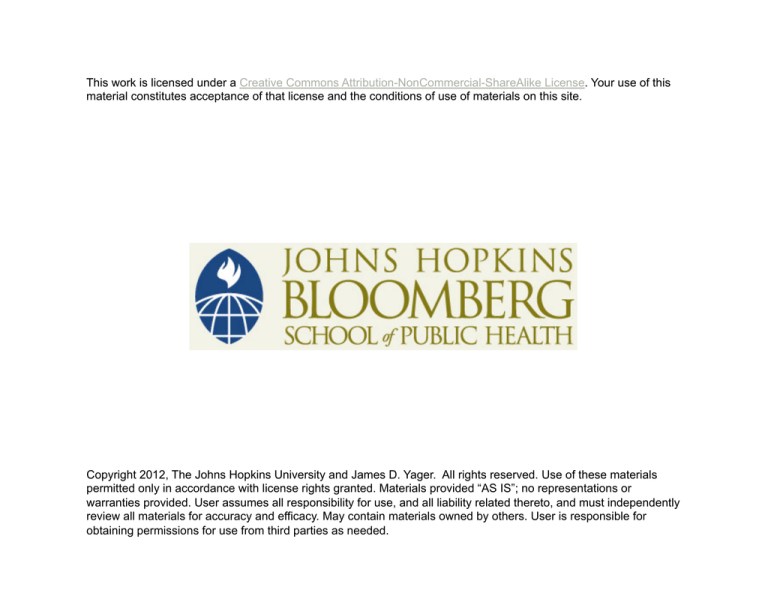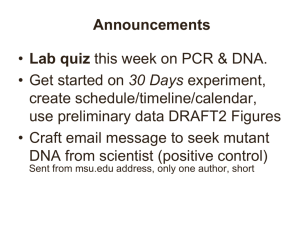
This work is licensed under a Creative Commons Attribution-NonCommercial-ShareAlike License. Your use of this
material constitutes acceptance of that license and the conditions of use of materials on this site.
Copyright 2012, The Johns Hopkins University and James D. Yager. All rights reserved. Use of these materials
permitted only in accordance with license rights granted. Materials provided “AS IS”; no representations or
warranties provided. User assumes all responsibility for use, and all liability related thereto, and must independently
review all materials for accuracy and efficacy. May contain materials owned by others. User is responsible for
obtaining permissions for use from third parties as needed.
Section C
Mechanisms of Carcinogenesis
Multiple Stages:
Initiation
Promotion
Progression
Multistage Carcinogenesis
Initiation:
– somatic cell mutation
Promotion:
– clonal expansion of initiated cells
Progression:
– evolution of neoplastic phenotype due to
continued mutation, chromosome
aberrations and/or epigenetic changes
• angiogenesis, invasiveness, metastasis
27
Carcinogenesis: A Progressive, Multistage
Process
28
Initiation and Promotion
Operational Definitions
Initiator
No
Tumors
Promotor
Many
Tumors
Photos by Tom Kensler
29
Initiation
Molecular target: DNA
– Carcinogen metabolism -> Activation ->
DNA damage
– DNA repair processes
Gene targets:
– Proto-oncogenes
– Tumor suppressor genes
30
Chemical & Physical Agents that cause DNA
damage are referred to as being Genotoxic
A hall mark of cancer is genetic instability at the
nucleotide and/or chromosomal level
DNA Damage ->
Mutation (mutagenesis)
–
“Point” or “gene-locus” mutation (base pairs), substitution, and
small deletions or additions
Chromosome breaks (Clastogenesis)
–
Results in gain, loss, or rearrangement of pieces of chromosome
Chromosome Number change (Aneuplody)
–
Gain or loss of one or more chromosomes
31
Types
of DNA
Damage
Intercalation
32
Specific Sites for Carcinogen-DNA Base Adducts
I
O
IV
N
6
HN
5
1
7
8
4
2
III
H 2N
3
N
Guanine
II
9
N
DNA
I. Alkylating Agents, Mycotoxins, estradiol
II. Aromatic Amines, oxidative damage
III. Polycyclic Aromatic Hydrocarbons, Alkenylbenzenes
IV. Methylating & Ethylating Agents
33
DNA Repair Processes
Replication errors
– Proofreading during replication
– Mismatch repair
Damage caused by endogenous and exogenous
agents
– Direct damage reversal
– Base excision repair
– Nucleotide excision repair
34
Nucleotide Excision Repair
35
Correlation Between DNA Repair Capacity
& Mutagen Sensitivity
Adapted from Wei et al. Cancer Epi. Biomarkers & Prev. 5:199-204 (1996); slide provided by J. Groopman
Key Points – Section C
Carcinogenesis is a multistage process
Initiation caused by mutation is irreversible
DNA is a major target for carcinogens
Damage may cause mutation leading to gain or loss of
function of key genes
A variety of DNA repair processes protect the cell from
DNA damage caused by exogenous and endogenous
agents
DNA repair capacity correlates with sensitivity to mutation
A hallmark of cancer is genetic instability
37





